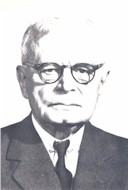Andrew G.L. McNaughton
Born 25 February 1887
Died 11 July 1966
Andrew G. L. McNaughton was born in Moosomin, Saskatchewan, Canada on 25 February 1887. He enlisted in the army reserve in 1909, but remained at McGill University studying and lecturing in electrical engineering, graduating in 1910. In 1912, he received his M.Sc. from the same university. At university, his research studies concerned measurements on high voltage systems. In his parallel Army career, by 1914, he was commanding the 3rd Field Battery in Montreal. His engineering, military and diplomatic careers overlapped in his interest and concern about the intersection of engineering, science and war, and in his strong sense of nationalism and pride for Canada.
World War I
With the outbreak of World War I, McNaughton served as Major in the Canadian Field Artillery on the Western Front. He was quick to make use of new scientific techniques including sound ranging in Canadian artillery operations. This creative application of scientific principles to the battlefield and his injuries gained him recognition in the form of the Distinguished Service Order, and promotion to Brigadier General by the end of the war.
Remaining in the Army after the war, McNaughton applied his engineering training to military needs. In the 1920s, he helped develop a northern radio signals system which incorporated the cathode ray detection finder, which would become an important advance in the development of radar, among other instruments. In 1926, along with Colonel W. R. Steel, he received a patent for the device.
His strong presence allowed McNaughton to advance rapidly in the military, becoming chief of the general staff with rank of Major General on the first day of 1929, a position he held until 1935. With the coming to power of the Conservatives in 1930, McNaughton’s influence grew. Between 1930 and 1935, when he left his post in Ottawa, he had held leadership positions and spearheaded inquiries into issues ranging from national unemployment relief to the St. Lawrence Seaway. His greatest national concern was the weak state of the military, and as a strong nationalist, the need for national control of the armed forces.
National Research Council and World War II
McNaughton’s concerns about war and war preparedness in a scientific age led him to the next phase of his career. From 1935-44 he was President of the National Research Council of Canada. During his active tenure of office as President of N.R.C., 1935-39, he fostered the growth of the engineering divisions, particularly in the areas of electrical, mechanical and aeronautical engineering, in physics and the applied Sciences generally.
On outbreak of war in 1939 he was appointed General Officer Commanding the First Canadian Division and sent to England. Here he continued to apply his knowledge and interest in science and engineering to military needs. He was promoted to Lieutenant-General and later General. With this rank, he was appointed General Officer Commanding-in-Chief of the First Canadian Army overseas. His sometimes stubborn personality and strong ideas eventually brought him into conflict with British leaders, and he left the Army in 1943. The next year, he became Minister of National Defence (Canada), at the time of the reinforcement crisis of 1944. In this role, he worked hard to avoid overseas conscription, but eventually failed.
Post War Diplomatic Career
Following the end of World War II, General McNaughton was Chairman, Canadian Section, Canada-U.S. Permanent Joint Board on Defence. He was Canadian Representative on the United Nations Commission for the Control of Atomic Energy and Permanent Delegate for Canada to the United Nations, and represented Canada on the Security Council. He also served as President of the Atomic Energy Control Board of Canada at that time. In 1950 he was appointed Commissioner and then Chairman, Canadian Section of the International Joint Commission. In this role, he helped complete the final international agreement on the St. Lawrence Seaway, including the hydroelectric plants.
McNaughton’s long and varied career resulted in many honors, including the Companion of Honour and Companion of the Order of the Bath, bestowed by the Crown, as well as engineering honors. He became an Honorary Member of one of the forerunners of the IEEE in 1942, and was awarded the IEEE Founders Award in 1964, “For his inspiring leadership and his personal contributions in the field of electrical engineering and radio communications.” IEEE Canada continues to honor his name with the A.G.L. McNaughton Medal for contributions to the engineering profession in Canada, and the IEEE Canadian Foundation offers Learning Resource Center Grants in his name.
General McNaughton passed away on 11 July 1966.
Additional Research
Andrew McNaughton. Encyclopedia of World Biography. 2004.
Andrew McNaughton Bio. The Juno Beach Centre.
McNaughton Papers. McGill University Archives.
